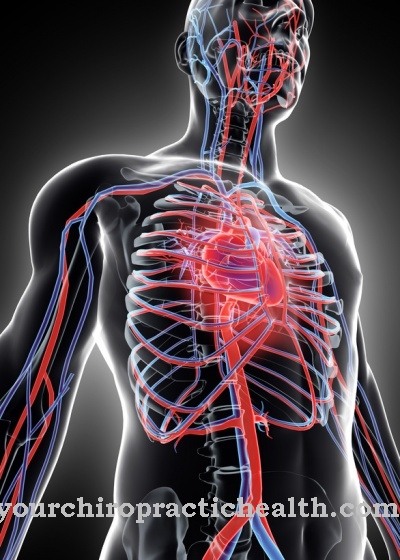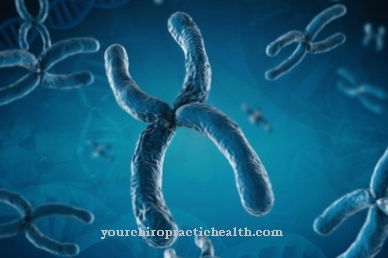The Kidney scintigraphy is a proven nuclear medicine examination method. It is primarily used for the separate assessment of the function of the kidneys and the urinary organs of the urogenital tract. This is made possible by the use of a very well-tolerated radioactive substance that is injected into the patient: By recording its excretion via the kidneys with a gamma camera, the kidney function can be reliably checked without invasive intervention in the body.
What is kidney scintigraphy?

The scintigraphy of the kidneys belongs to the field of nuclear medicine and is a meaningful diagnostic supplement to the classic examinations such as sonography (ultrasound) and special blood tests.
Kidney function is measured by a radioactive substance that is usually injected into the patient's vein in low doses. The tracer used to track the uptake and excretion of fluid by the kidneys is in most cases technetium, a chemical element. Due to its natural radiation, it is possible with the help of the gamma camera to convert the course of the fluid enriched with this substance in the area of the kidneys and the urinary system into meaningful image material.
These images are called scintigrams. In addition, the performance of the kidneys is also expressed as a percentage with the appropriate software and compared with the established standard values. In contrast to laboratory analysis of the relevant blood values, kidney scintigraphy can show the function of the two kidneys separately. To round off the diagnosis, however, scintigraphy is often combined with an examination of the kidney values in the blood.
Function, effect & goals
With kidney scintigraphy, nuclear medicine has an effective instrument if you want to examine the blood flow to the two kidneys, their functionality (kidney clearance) and, above all, their performance in terms of excretion, i.e. the flow of urine into the bladder, separately.
Pathological processes such as tumors or inflammation in the area of the renal pelvis and ureters as well as urinary outflow disorders of various causes can be discovered in this way using non-invasive diagnostics. Kidney scintigraphy is also suitable for depicting possible consequences of high blood pressure, such as the relevant narrowing of renal arteries.
It is also used for special issues - for example, with regard to the success of a kidney transplant or an operation in the urology department, as well as for young children with malformations in the urinary organs. With chemotherapy or radiation therapy, the functional performance of the kidneys can be monitored with scintigraphy without an invasive procedure. All of this enables the administration of a small amount of a radioactive and kidney-penetrating tracer, which is usually administered into the arm vein.
No special preparation for this examination is necessary. Only certain X-ray examinations should be avoided in the last two days before the nuclear medicine diagnosis, as the contrast agent used can falsify the informative value of the scintigraphy. If damage from high pressure is to be diagnosed, blood pressure medication may also have to be discontinued after consulting the doctor. However, it is important to drink enough in the run-up to the examination - especially in the last 30 minutes before it.
In this way one achieves a good accumulation of the tracer in the kidney tissue and an adequate excretion. The flow of urine can also be increased by the administration of diuretic drugs to drive the body shortly before the examination. The images are made in the supine position.
The gamma camera records the physiological processes in the kidneys and urinary organs over a period of about 30 to 40 minutes. Due to the rapid excretion of the radioactive tracer, it is possible in this relatively short time to get a comprehensive picture of the individual question of the kidney scintigraphy performed. It is not uncommon for the high informative value of scintigraphy to determine clinical pictures before they become apparent in laboratory diagnostics through changes in blood values.
Risks, side effects & dangers
Like all other examination methods in nuclear medicine, kidney scintigraphy causes fear in many patients because of the radioactive drug that is injected into the arm vein. However, this is unfounded, as the radiation exposure caused by the tracer is low and is in the range of a classic X-ray examination, for example of the lungs.
In addition, the radioactivity leaves the body quickly through natural excretion via the kidneys or the urinary tract. Consistent drinking after the examination can support this process. A relative contraindication - that is, the benefit and urgency of the examination must be carefully weighed up by the doctor - only applies to pregnancy and breastfeeding. The doctor recommends that breastfeeding mothers express their breast milk for 48 hours and discard it because of the radionuclide administered.
In addition, after a kidney scintigraphy - as after any nuclear medicine examination - patients should keep contact with pregnant women or young children to a minimum for about a day. An intolerance reaction to the injected tracer is also usually not to be expected.
Compared to the contrast media that are used, for example, in the context of a CT (computer tomography), technetium can usually be used without hesitation even in patients with a high allergy potential. The recording itself by the gamma camera is absolutely painless. There are no restrictions after the kidney scintigraphy, so that the patient can carry out his private or professional obligations as normal immediately after the examination.




.jpg)








.jpg)

.jpg)
.jpg)











.jpg)